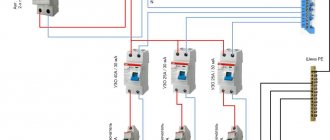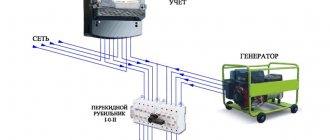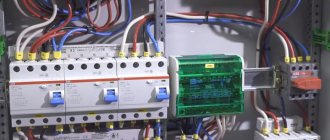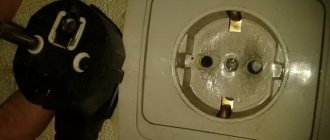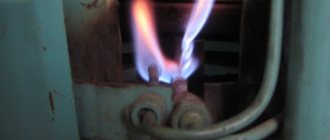Where does zero break occur?
It is fundamentally important that a zero break can occur in three-phase or single-phase networks.
Completely different processes take place there; I’ll go into detail below. In short, what happens:
When the zero is broken in a three-phase network, a phase imbalance appears, which can lead to the voltage in the apartment outlet increasing to 380 V! For a person, if grounding is performed correctly, such an accident is not dangerous. But for our electrical appliances, the consequences can be very sad! And also for our home, since a fire may occur.
The location of the zero break may be a floor panel, then only apartments on one landing are in the risk zone. Or maybe it’s the input switchgear of a multi-storey building. For example, this:
The input switchgear (RU) in the basement of a multi-storey building is in poor condition
If the zero in a single-phase network breaks, the consequences are not so sad - the voltage in the outlet will be zero, and electrical appliances simply will not work. However, the entire electrical network (and if the grounding is incorrect, even the housing of electrical appliances!) will be at a potential of 220 V!
To begin with, to create fear -
Parallel circuit
With a parallel connection, the phase and neutral conductors simultaneously reach all consumers in the circuit. Let's draw a diagram where these consumers are ordinary incandescent light bulbs.
The input voltage is 220V. With this connection, the voltage on each light bulb will be the same, and with a sufficient cross-section of conductors and a low load, it will not differ much from the input one.
In this case, turning off or turning on each light bulb in turn will not greatly affect its values. It is according to this scheme that all sockets in your apartments are connected.
However, if the voltage is the same, the current in the circuit will be different. Its total value is the sum of the currents passing through bulb No. 1 and No. 2.
You can turn on more powerful devices (200W lamps, kettle), and everything will work perfectly.
Consequences of a zero break in a three-phase network
I'll tell you stories from my life.
- Electricians were repairing the entrance to the entrance. And during the repair, the working zero was turned off for a few seconds. A very unpleasant thing happened: when people returned home in the evening, they discovered that their TVs, refrigerators, chargers, etc. had burned out. - something that is constantly plugged into our outlets. It's good that there hasn't been a fire yet.
- Came on call, complained - tension was floating. I measure the voltage (everything is turned off) - almost 300 volts. Then, when the incandescent lamp is turned on, the voltage drops to 70V... It turned out that a bolt had burnt out in the floor panel, which received a zero. There was a break in the zero, a phase imbalance, and voltages went wild. I replaced the bolt, restored contact, and the voltage returned to normal.
Scratch bolt. Rusty, periodically does not contact!!! If you change it without turning it off, 100% of the equipment in the entrance will burn out!
An article on how I changed the electrical panel there is here.
- I was called to an advertising and publishing company. According to preliminary estimates, the damage is more than 100 thousand rubles, and all due to poor contact on the zero bus:
Zero burnout from the zero bus
The neutral wire burned off from the second bolt. You can see how it fell off under tension. Before falling off, it ALMOST melted the insulation of the phase wires (vertical, red and white).
The server has not been turned on yet, perhaps the intellectual damage will be greater...
At the site of this tragedy, I installed a three-phase voltage relay Barrier, read the article at the link.
As you can see, such problems occur due to incorrect actions of “electricians” or due to spontaneous breakage (burnout) of the neutral wire in the old housing stock.
In this article I will tell you in detail why this happens and how to deal with it.
The main reasons leading to electrical wiring breakdowns
With proper selection of a high-quality cable and compliance with installation technology, the wiring lasts quite a long time without causing any problems to the owners.
But in fact, there is often a disruption in the operation of electrical networks, which is provoked by the following reasons:
- Using the wire for a long time
In old buildings, aluminum wires were usually installed, which tend to quickly deteriorate, and any other wires age over time, the plastic insulation becomes inelastic, brittle, and breaks. Leakage currents begin in the cracks, which in the absence of an RCD cannot be immediately detected, conductivity decreases, resistance increases, and a short circuit may even occur and the electric current will completely stop.
- Cable damage during repair
To drive a nail or drill a hole in a wall, you need to know the route of the installed electrical networks. Otherwise, you can get caught in the wire, causing it to break and sometimes even short circuit. Sometimes only a section of the cable is affected, which leads to complete destruction of the core after a certain time.
- Poor quality wiring or electrical installation performed with errors
A bad cable wears out faster. When voltage fluctuations occur, weak wires will overheat, and damaged areas may ignite if the network is overloaded.
- Excessive load on one cable
If one tee or extension cord contains several devices with high power consumption, this can cause overheating, melting of the insulation and breakage of the electrical wiring.
Regardless of the reason, if the wires break down, you should immediately find the location of the break and urgently fix the problem.
Formation of single-phase and three-phase networks and zero break
A little theory.
As you know, powerful consumers (in this case, apartment buildings) are powered by a three-phase network, in which there are three phases and zero. I already wrote about this system in detail in an article about the differences between three-phase power supply and single-phase power supply, here is a picture from there:
Voltages in a three-phase system
Let's look at this issue again, only from the other side.
This is what a simplified diagram of the power supply to the floor panel looks like:
Power supply system, without zero break. Three apartments are designated by resistors.
Phase wires L1, L2, L3, on which there is a voltage of 220V in relation to the neutral wire N, are marked in red because they pose a danger. The PE grounding is shown below; its wire is connected in the switchgear at the entrance to the building with the neutral.
For more details, I once again urge you to read my article about grounding systems, link at the beginning.
What are the dangers of old electrical wiring in a house?
First of all, there is a fire danger . Secondly, it is a danger to life and health (current up to 36 volts is considered safe for humans). And thirdly, poor outdated electrical wiring means unstable operation and failure of equipment, and breakdown of expensive household and lighting fixtures.
Old aluminum wiring
- Signs of old wiring
- Danger of aluminum wiring
- Twists and junction boxes
- The dangers of old sockets
- Lighting in old houses
- Complete wiring replacement
What does zero burnout lead to in a three-phase network?
What will change if the neutral wire N breaks BEFORE the junction of the neutral wires at one point? There will be a zero break in a three-phase network:
Zero break in a three-phase network
If you look at the diagram, to the right of the break point the voltage will now not be zero, but “walk” within arbitrary limits.
What happens if the zero is disconnected (accidentally or intentionally)? What voltages will be supplied to consumers instead of 220V? It depends.
The picture in a different form may be easier to understand:
Phase imbalance as a result of zero loss.
Consumers are conventionally shown as resistances R1, R2, R3. The voltages indicated in the previous figure as ~220V are designated as ~0...380V. I'll explain why.
So, what happens if the zero disappears (the cross in the lower right corner)? In an ideal case, when the electrical resistance of all consumers is the same, nothing will change at all. That is, there will be no phase imbalance. This happens when three-phase consumers are turned on, for example, electric motors or powerful air heaters.
But in real life this never happens. There is no one in one apartment, and only the TV is on in standby mode and the phone is charging. And the neighbors on the site did the laundry, turned on the split system and electric kettle. And then - BANG! - the zero burns out.
Phase imbalance begins . And how brutal it is depends on the real situation.
For neighbors who are at home, the kettle will stop heating, the washing machine and splitter will go out, and the voltage will drop to 50...100V. Because the “resistance” of these neighbors is much lower than that of those who are not at home. And so, these people are quietly working at work, and at this time in their empty apartment their TV and Chinese charger are smoking. Because the voltage in the sockets jumped to 300...350V.
These are real facts and figures, this sometimes happens, the condition of electrical panels on staircases is often disastrous. Even when a major renovation is carried out in the house, the panels are not touched, since changing the electrical system is much more difficult than painting the house and installing new windows.
Such a fire should be investigated not by calling psychics (you never know, a poltergeist is playing with matches;)), but by calling an electrician.
Now - about
Every homeowner should know the location of the power supply route.
In most cases, owners resort to searching for a diagram of the location of electrical communications in the house when problems have already arisen.
Meanwhile, you should think about this in other cases:
- Before remodeling your home
During the reconstruction of a room, when changing its configuration, it is necessary to take into account the location of the electrical network so as not to cut off the power to the apartment or house.
- When installing lamps, hanging pictures, shelves or suspended ceilings
When carrying out any wall work, you need to know where the wiring runs so as not to damage it with a nail or drill through it.
Wiring damage often occurs during the installation of suspended ceilings. The corners at which the ceiling is attached are attached to the wall with self-tapping screws, and often these fasteners end up on the electrical wire line.
- After purchasing a home
Every owner must have a circuit diagram. Therefore, it should be drawn up immediately after purchasing a new premises. The plan must indicate the routes of electrical communications and the location of switches, sockets and junction boxes. In the future, the diagram will be useful when arranging furniture and during repairs.
Zero break in a single-phase network
Here the picture will be as follows:
Zero break in a single-phase network
For a load that operates on other phases, nothing will change at all. It’s the same as if you turn off the automatic circuit breakers in your apartment – your neighbors won’t give a damn.
But if a break occurs, for example, in a panel, then the entire apartment, including the broken end of the neutral wire, will be under 220V voltage!
Breakage (burnout) happens because of rusty bolts like those at the top of this photo:
Bad zero. Missing zero in the apartment
I repeat - if the grounding is done correctly, or if there is no grounding at all, this accident is not dangerous in any way. And, of course, you don’t need to touch the wires without waiting for an electrician - all have deadly potential!
Okay, we understand who is to blame. What to do?
conclusions
Finding a broken wire is a rather difficult and serious matter that requires certain skills and knowledge.
To quickly find the location of a damaged electrical wire, you need to know the layout of electrical communications. You can use logic to determine the area where an accident could have occurred. Find the exact location of the break, possibly using homemade or professional devices. You should find out which wire has burned out: phase or neutral, using the recommendations given in the article.
Using the information obtained, you can easily not only find the damaged wire and restore it, but also prevent a similar breakdown in the future.
How to protect yourself from zero loss?
The best protection against zero loss in a three-phase network is a voltage relay, which I have written about on the blog more than once. Here are my two main articles - About the Barrier voltage relay and the EuroAutomatika FiF voltage relay.
Because of its main function, this relay is also called Zero Break Relay.
Another option is to use a voltage stabilizer. It must have protection against low and high (up to 380V) input voltage. And if it is impossible to stabilize the voltage, it must turn off the apartment, but remain operational.
The best option for protection against zero loss and generally unstable voltage is to use a voltage relay, followed by a stabilizer.
As an option for additional protection in the event of a zero break, an RCD (or differential circuit breaker) can help. But it’s not that simple, details are in the video:
That's all for today, join the discussion, ask questions in the comments!
Finding the exact location
Having established the approximate affected area, you should begin an in-depth search for the location of the damage, which can be done using different methods. There are various ways to find a damaged wire.
Opening a wall during a major renovation
The easiest way to detect cable damage is to completely clean the walls of finishing materials. In this case, it is easy to inspect the grooves made to accommodate hidden cables. They differ in color from the rest of the surface, and additional putty is applied to them.
However, since in this case complete exposure of the walls and dismantling of decorative coatings (paint, wallpaper) is required, it is therefore advisable to use it during a major renovation of the room, which involves a new design of vertical surfaces.
Boolean search method
If residents do not have an electrical plan, you can try to recreate it using logic.
Professional electricians are well aware of the basic principles of laying electrical communications, namely:
Knowing the location of sockets and switches, you can create a communications diagram in the apartment.
However, to check the proposed layout of electrical networks, it is advisable to use special devices (professional or homemade), which will be discussed below.
Tools at hand: radio and microphone
If necessary, a conventional transistor receiver will allow you to identify the affected area of the cable. It must be tuned to 100 kHz waves and brought to the intended affected area. Above the place where the electrical network passes, the noise of the receiver will intensify, and above the place of the break the crackling will subside.
Instead of a radio, you can also use a microphone from a portable tape recorder. It should be plugged into the network and routed above the wall surface where the faulty cable is believed to be located. As in the previous version, a crackling noise will be heard above the power line, which will cease when a break is detected.
It is important to take into account that improvised devices give an error of 10-15 centimeters. In order to avoid electric shock when performing repair work, it is better to play it safe by taking additional precautions.
The following will also help in finding a break in the wiring hidden in the gate:
Search using professional equipment
Special devices - hidden wiring indicators - allow you not only to detect the cable, but also to find the area where the burnt or broken wire is located.
Among the various devices used to locate damage are:
These and similar devices provide quick and reliable results, but have certain disadvantages. First of all, with their help it is impossible to find a cable protected by a foil shield.
Such devices react not only to electrical wiring, but also to other metal objects, for example, nails and screws in the wall. Finally, although these detectors are easy to use, operating them requires attention and skill.
You can also examine the wire in the wall using an indicator screwdriver, but this method is only suitable for cases where live wires are located at a shallow depth in the concrete.
Bosch DMF 10 zoom, VP-440, POSP-1, GVT-92, GVD-504A and others are also suitable for detecting hidden wiring and conductor damage points under plaster. It is possible to use a locator or other professional equipment.
Checking wiring with a homemade device
An alternative to expensive professional equipment can be a budget metal detector made from scrap material.
One of the most popular options is a device made from old CDs. Despite the apparent simplicity of this device, it allows you to find live wiring located under decorative trim at a depth of up to 10 cm.
For the device you will need:
After this, you can test the device, which will produce sound over metal objects.
Modern construction technologies often involve the use of beacons or markers in places where electrical networks pass. This greatly simplifies the process of searching for a damaged core using both professional and amateur means.
How and with what to extinguish a burning wiring?
To extinguish fires on elements or sections of the electrical network that are energized, it is strictly prohibited to use water. Since if it comes into contact with a person, there is a risk of electric shock. Therefore, to extinguish fires in electrical installations defined by the classification in paragraph 1 of GOST 27331-87, only fire extinguishers are used that use aerosol, carbon dioxide, or powder as extinguishing material.
Figure 4: extinguishing electrical installations
But they also make it possible to fight fires only in devices up to 1 kV. And all electrical installations over 1 kV must first be de-energized.
Troubleshooting
If the problem occurs in the new wiring, the ends of the wire must be connected. The connection is made as follows:
- The phase conductor must be disconnected from the power supply.
- To the left and right of the break point you need to remove the plaster from the wall. Ultimately, you need to release at least 10 cm of wire.
- The ends of the emergency wire must be pulled apart and a hole drilled in the wall for the branch box. The hole is marked with a hammer drill with a crown attachment, and the hole is selected with a chisel.
- Place the box in the prepared hole, secure it with alabaster and insert the wires into it.
- If there is a supply, the ends of the damaged wire are connected to each other according to the color of the insulation and carefully insulated. The connection is made using PPE.
- The box is closed with a lid, the repair area is plastered and the finish is restored.
In some cases, the damaged area must be completely replaced by pulling it through the corrugation using a broaching device.
The procedure for repairing a damaged neutral conductor is slightly different from repairing a phase. The neutral wire is disconnected from the bus and the phase wire is attached to it. After this, all other actions are performed in the same way as when eliminating a phase loss.
Scope of application of protective grounding
Protective grounding is used in electrical installations with voltages up to 1 kV:
- — in direct current networks with a grounded midpoint of the source;
- — in single-phase AC electrical networks with a grounded terminal;
- - in three-phase AC power networks with a grounded zero (TN - S system; as a rule, these are networks 660/380, 380/220, 220/127 V);
| Protective grounding is designed to protect against possible electric shock. For example, a situation arose when the insulation inside an electrical installation was damaged and the body of the installation (for example, a washing machine or refrigerator) became energized. In this case, a short circuit current occurs to which the protection (machine or plugs) reacts and instantly disconnects the electrical installation from the network. |
The formation of a single-phase short circuit current circuit (i.e. a short circuit between the neutral and phase protective conductors) occurs in the event of a phase wire shorting to a grounded housing of the electrical consumer. The damaged electrical installation is disconnected from the supply network due to the activation of protection caused by single-phase short circuit current.
To quickly disconnect the electrical installation located, circuit breakers and fuses installed to protect against short circuit currents can be used. Also for this purpose, magnetic starters with built-in thermal protection, contactors with thermal relays are used, which provide overload protection, etc.
What to do if it shorts: emergency actions
If there is a power outage in your home, you should make sure that there is an emergency at home.
Smoke and the acrid smell of melted plastic will tell you about problems. It is necessary to turn off the machines, unscrew the plugs on the electrical panel, and disconnect electrical appliances from the sockets. It is better to put out an open fire by covering it with a blanket or thick cloth.
If you have a powder (car) or carbon dioxide fire extinguisher, be sure to use it to extinguish the fire. Do not pour water on the fire!
The causes of serious electrical faults are varied, but in most cases are known. The occurrence of a short circuit is associated with improper operation and violation of clause 2.1.21 of the PEU rules during installation of electrical wiring.
